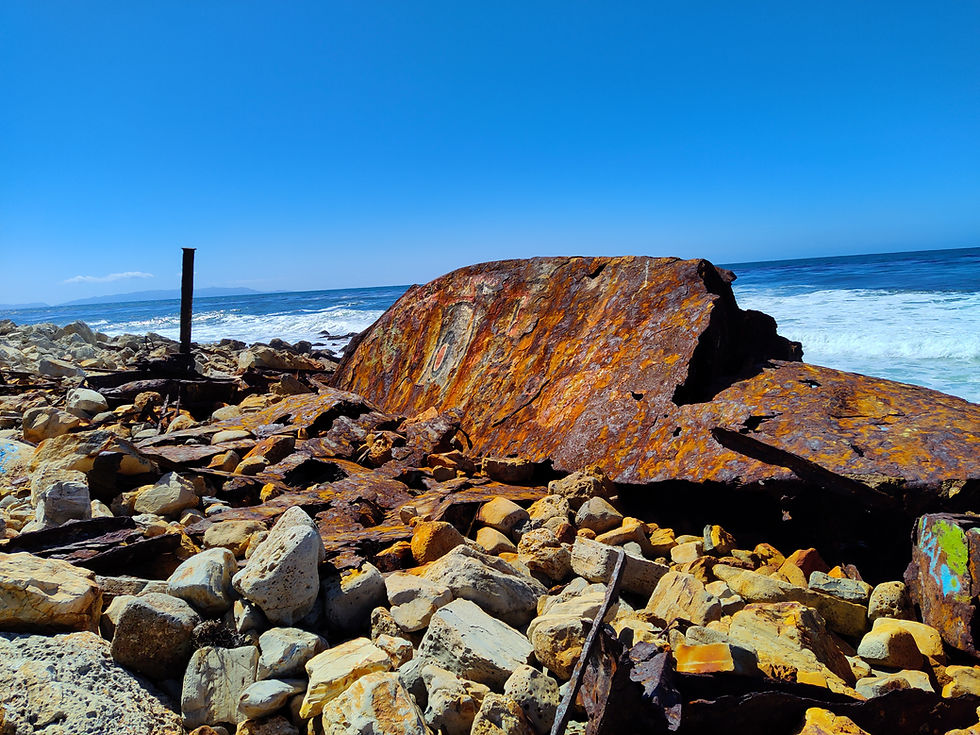"Walking down a rusty memory lane" S.S. DOMINATOR - 2021
- storiedtreasures88
- Aug 26, 2021
- 4 min read
Updated: Oct 17, 2021

This trip, my first to the site in 11yrs, was conducted with Galen Patterson and represented my first major hike since I'd fallen and injured myself on a previous expedition. Approaching from the North as I had years before it was somewhat jarring to see the trail that Meghan and I had taken was now completely washed away. I retraced my steps almost robotically and the beginning of the old path led straight to a sheer drop-off. To the side, a new path had been cut into the jagged hillside and met up with the remnants of the old one. Upon reaching the bottom the coastline was drastically changed and previous landmarks seemed to be missing. The hatch cover and old steam pipe were no longer visible, and I can only deduce they were buried in the rocks now underfoot.

The coastline was considerably 'higher' than I remember and given the fact the wreckage I'd previously seen was gone, I can only conclude that rock-slides and erosion to the hillside have buried parts of the wreck once found here.
The large bit of hull and ribbing was more-or-less where I remembered it, however, it had been turned slightly and was now much flatter than before... the rusted iron buckling under its own weight. The large steam pipe which I deduced was from the boiler and funnel ventilation as still where it should have been, however, a lot of debris was visible which had either been buried or unnoticed in my 2009 visit. There appeared to be much more of the wreck scattered in this area than before, and someone had taken a large section of it and set it under a tree to be used as a bench.
The crane wreckage was exactly as I left it, minus a few pieces of wood and a thicker coating of rust. At first glance, I could not tell if it had pivoted slightly but this turned out to be my imagination. The mast was nearby and exactly as I'd left it, though it had more debris around it than I remembered and I noticed that a large number of the debris bore some signs of grafitti. 'A sign of the times' I thought to myself somewhat depressed.

The bow section broke my heart though as it was almost completely gone and unrecognizable. In the intervening 11 years since my last visit the thin sheet metal had completely disintegrated and thus the structure had collapsed. The big gears and winch I'd seen before remained unchanged, though they were partly covered by the 'tubes' which once fed the anchor chains. Gone was the streamlined shape of the bow, fallen away were the mooring bitts, the hawsers for the anchor chains, and as previously noted even sheared away were the tubes which once fed the anchor chains.

The remaining metal, jagged and curved, bore no resemblance to the ship I'd last seen, and I estimated it to measure no more than 8ft by 6ft in size. It took a lot of imagination to see what once was compared to what I was seeing now.

Not far away the bottom of the ship remained largely the same and still upside-down, albeit sitting much lower in height than I remembered. Turning back to the 'Bow' debris I noted that one set of 'fairleads' remained stubbornly affixed to the remnants of the metal, though I comically thought that perhaps it would be more apt to say that there are remnants of the metal affixed to the fairleads instead of vice versa as the old rollers for docking the ship will likely forever remain there long after the ships thin sheet metal has decayed.
Just faintly visible in the waters just offshore are several dark patches of kelp where additional wreckage is to be found. A Youtuber "Ocean Earth Green" free dove the outer wreckage and discovered the ship's massive engines still standing upright on the bottom as well as the stern section with the propeller shaft and lower hull largely intact.

We walked a little further down the coastline in search of my mythical 'safes' but not a trace of them could I find, and I noted numerous rocks which were not there before. I believe they are now buried in landslide material.

Walking further along past the wreck to retrace the steps my father and I took in 2003 I took the opportunity to snap a near perfect 'Before & After' image. It is incredible how the iconic bow has vanished in the years since I first saw it. 18 years doesn't seem like a long time honestly, but for the Dominator it was a lifetime.

Before we left the site Galen helped me retrieve a solid artifact... a large piece of rusty metal with twin rivet holes. Given my previous experience with rusted iron from the ship, it was quickly given a soak in distilled water and then a bath in vinegar ((pictured here)) to clean as much surface rust as possible. The stabilized piece now sits on a display with other relics I have collected from my various expeditions and hunts to share with others in my ongoing presentations. In conclusion: The Dominator is an interesting but dangerous hike. I would recommend a good and solid pair of shoes to be paired with a walking stick in case someone were to lose their balance on the rocky beach. This is one place you absolutely do NOT want to trip and fall as there are razor-sharp shards of metal everywhere and much more wreckage is often hidden unseen in the rocks with which you are walking upon. Still, for all the risks, it is a nice place to hike with some beautiful scenery along the coast, and for the avid historian, the wreck offers a good tale to tell with a lot of bits and pieces to explore both ashore and beneath the waves nearby.
Matthew R. Smathers
Expedition Leader,
STORIED TREASURES
August 26th, 2021






































Comments